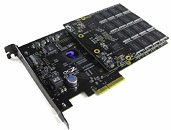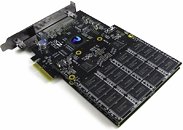Thursday, October 28th 2010

OCZ Launches RevoDrive X2 Second Generation Bootable PCI-Express SSD
OCZ Technology Group, Inc., a leading provider of high-performance solid-state drives (SSDs) and memory modules for computing devices and systems, announces the launch of The RevoDrive X2 PCI-Express SSD, a follow-up to the successful launch of the first RevoDrive, with increased performance and capacity to serve high-performance computing consumers. The RevoDrive X2 upgrades the original architecture to deliver unprecedented speed up to 740 MB/s and up to 120,000 IOPS, nearly triple the throughput of other high-end SATA-based solutions with a substantial reduction in the total cost of ownership (TCO) to the consumer. The product is available now through OCZ's global channel.
"The original OCZ RevoDrive SSD was designed to be the first high-performance, bootable PCIe SSD solution and has become a popular choice for demanding computing applications that require faster, more reliable storage," said Ryan Petersen, CEO of OCZ Technology. "Building on the success of the original design, we are excited to introduce the RevoDrive X2, which delivers both increased performance and capacity, making the RevoDrive X2 a viable option for a wide spectrum of applications that include professional graphic design, multimedia rendering, and workstations. With our recently announced new state-of-the-art SSD manufacturing facility in Taiwan, OCZ will continue to be at the forefront of developing and deploying game-changing solid state storage solutions."The RevoDrive family gets its edge by eliminating the SATA II (3Gbps) bottleneck and leveraging a PCIe x4 interface to exploit the full potential of current flash technology. Like the original RevoDrive, the X2 uses an onboard RAID 0 design, but it also employs four SandForce-1200 controllers versus two in the original to maximize data access and bandwidth. In addition to promoting a faster, more responsive PC experience, the RevoDrive X2 is bootable, unlike competing PCIe solutions, to ensure quicker start-ups and load times compared to mechanical hard drives, a major plus for workstation PCs.
The RevoDrive X2 thrives in a wide range of computing environments including demanding database and server applications as well as multi-media creation and management. Available in 100GB to 960GB capacities, the OCZ RevoDrive X2 provides ample room for data warehousing, applications, multimedia files, and operating systems. Additionally, the X2 provides the superior durability, energy efficiency, and reliability of SSDs.
For more information, visit the product page.
"The original OCZ RevoDrive SSD was designed to be the first high-performance, bootable PCIe SSD solution and has become a popular choice for demanding computing applications that require faster, more reliable storage," said Ryan Petersen, CEO of OCZ Technology. "Building on the success of the original design, we are excited to introduce the RevoDrive X2, which delivers both increased performance and capacity, making the RevoDrive X2 a viable option for a wide spectrum of applications that include professional graphic design, multimedia rendering, and workstations. With our recently announced new state-of-the-art SSD manufacturing facility in Taiwan, OCZ will continue to be at the forefront of developing and deploying game-changing solid state storage solutions."The RevoDrive family gets its edge by eliminating the SATA II (3Gbps) bottleneck and leveraging a PCIe x4 interface to exploit the full potential of current flash technology. Like the original RevoDrive, the X2 uses an onboard RAID 0 design, but it also employs four SandForce-1200 controllers versus two in the original to maximize data access and bandwidth. In addition to promoting a faster, more responsive PC experience, the RevoDrive X2 is bootable, unlike competing PCIe solutions, to ensure quicker start-ups and load times compared to mechanical hard drives, a major plus for workstation PCs.
The RevoDrive X2 thrives in a wide range of computing environments including demanding database and server applications as well as multi-media creation and management. Available in 100GB to 960GB capacities, the OCZ RevoDrive X2 provides ample room for data warehousing, applications, multimedia files, and operating systems. Additionally, the X2 provides the superior durability, energy efficiency, and reliability of SSDs.
For more information, visit the product page.


46 Comments on OCZ Launches RevoDrive X2 Second Generation Bootable PCI-Express SSD
The original RevoDrive carries a price premium of only about $80 to get nearly double the speeds next to a 285MB read/275MB write conventional SSD which is about $600 if you look on the egg.
The new revision of this drive that comes out will have even better speeds and will replace the current gen of RevoDrive SSDs. IMO, this is a win for rich people. And I for one......am not 1 of them :laugh:
For me, I think I'll just wait for the new waves of SSDs that will use the Sandforce 2xxx controller.
I like OCZ and I like this product but no TRIM is not a good idea and is really a deal breaker.
2.) As I said, I don't think TRIM is possible on a setup like this as the SSDs are invisiable to the OS, it just appears as a RAID Volume. The OS had no idea if that RAID volume is HDDs or SSDs. It is one of the downfalls of RAIDing SSDs.
Edit: It seems Intel is the only one that has managed to get TRIM working with the RAID chipset, and it is only on ICH10R motherboards, not dedicated RAID chipsets like the one used on the Revo.
The speed will be here via cards and drives, what we need next is lower prices.
X1 slots of PCIe 2.0 run closer to 500 MB/s per lane.
both of which are slower than that of the rated speed.
The card itself has pins specifically made for PCIe X4 so if you plug it into the X1 slot you will have open pins on the card. I would not recommend running it in a X1 slot. It may not even work without the X4 slot.
So in Linux it will show up as 4 drives unless they have released better drivers for the RAID chipset since the original(or changed the RAID chipset completely, which isn't likely since this is identical to the original just with a second PCB with more SSDs added).
To tell the truth, I never really liked how OCZ setup up the Revo. I don't like how they have used a PCI to PCI-E bridge chip and a PCI RAID chip, it adds latency which defeats one of the main purposes of SSDs, low latencies.
The Revo is set up like this:
[PCI-E x4 Slot]---PCI-E x4 Link--->[PCI-E to PCI Bridge Chip]---PCI Link--->[SiliconImage PCI RAID controller]===SATA 3.0Gbps Links===>[Sandforce SSDs]
The cheaper setup I posted earlier in the thread would actually probably perform better thanks to the RAID controller being PCI-E native and not needing a PCI to PCI-E bridge chip. Using a PCI controller with a PCI-E bridge chip is way old tech from back in the beginning of PCI-E days.:shadedshu
compared to the pci-e lanes. which is really faster: sataII@6gbs or pci-e??
thats what really matters to me. i know there are in fact ssd's and hdd's that are comming
to market with sataII@6gbs interface early next year.that whole "bottleneck" claim
throws a wrench in the cogs for me. has it been tested yet? are there any benchies to see
and compare??i'm not rich or swimmin in money but my next upgrade for my pc will be
a better c:drive and more storage.if this thing can really deliver on its claims,it would be
worth taking a second look at it.:confused:
where your mouth is" OCZ!!:slap:
I personally think that 160gb is the perfect boot + programs + most games... Then you put your old games + data (music,downloads,setups&drivers,etc.) on a mechanical HDD